
Posted
I restarted this discussion as a new thread, because the original one is more than seven years old and things have changed a lot since then (resurrecting outdated discussions has several issues, but this forum software can't handle this)
As the title implies, it's about a possible VST version of HN, which is still a standalone MIDI application to this date.
Meanwhile Synfire has evolved into a plugin host with DAW sync and Drones and all. We are indeed interested in learning more about how the proposed HN VST would actually be used, workflow wise, since the palette is a rather isolated feature of an otherwise much more comprehensive workflow.
Mon, 2018-12-31 - 23:31 Permalink
I agree. Strip off all the instrument tools and simply have midi in/out. Drag and drop to your sequencer. Get rid of loopbe30. This is the most intuitive palette tool I've seen in 40 years. You could even strip off the bar tool and just latch it to the daw. This thing would be absolutely killer if you would strip the garbage surrounding it for a vst. I just bought this thing and i spent 45 min finding really new inspiring progressions and 16 hours trying to get it to work correctly to feed my DAW. And please let us feed our own tunage into the preview sounds. I'm already sick of the ones you made. P.S. I will still recomend this to any and all who are learning musc theory. It's fantastic.
Thu, 2019-01-03 - 15:05 Permalink
i spent 45 min finding really new inspiring progressions and 16 hours trying to get it to work correctly to feed my DAW
Ouch! That 16h is what I'm hoping to avoid. Did you settle the yes/no/how of it? Or are you still kinda up-in-the-air with it?
This is the most intuitive palette tool
Yes, I really like it too. The pallette was the deal-maker for me, but the output path to the DAW does not seem to be "just happening intuitively" as I was hoping it would.
I know I have a great deal to learn here - but I really would like to know the "Nope, can't do that, don't waste time trying!" 's up front.
-
For my update on this, in relation to André's post immediately below see: (https://users.cognitone.com/comment/17150#comment-17150)
Wed, 2019-01-02 - 13:09 Permalink
Export is as simple as drag & drop: Grab the instrument name, drag away from HN, tap spacebar to tell HN you want to export rather than move elsewhere inside HN, and then drop it on your DAW track. With Advanced Edition, this also works for the entire song, or sections thereof (grab the section)
Wed, 2019-01-02 - 13:55 Permalink
Back to HN as VST:
I agree the full blown instrument setup with devices and racks is more than HN actually needs (it's is very different with Synfire, but we're talking about HN here, so whatever can be simplified will be appreciated by most users).
So much is clear however, a HN VST will be confined to the boundaries of a single DAW track, only feeding a single sound. Anything towards feeding multiple tracks and sounds will be as complex to setup as it is now. If not even more complex, because every DAW has different ways of routing MIDI and sound. Let's face it: DAWs are built to control VSTs - not the other way round. Its strictly top-down, a one way street.
This is not to say there aren't cool ways of hacking around this limitation. Synfire's Drones are doing exactly that: Kind of hijacking a DAW for the purpose of granting Synfire full remote control access to its tracks. Still, most Synfire users prefer working in Synfire standalone until the very last stages of production, as that offers the most comfort. Drones are out of question for HN, anyway.
This leads to the conclusion that only a basic single-track version of HN would make sense as a VST. A palette tool that outputs a chord progression. What I would like to learn more about is: After you dragged a chord progression to the DAW, what are you doing with it? How do you put it to use?
Thu, 2019-01-03 - 19:14 Permalink
A chord progression, once I drag it to the DAW, is later output to somewhere.
Somewhere is sometimes as simple as driving a hardware or software instrument with a string-pad or piano sound.
Often though, somewhere is an algorithmic generator (could be as simple as an arpeggiator, or as complex as Stephen Kay's amazing KARMA software).



